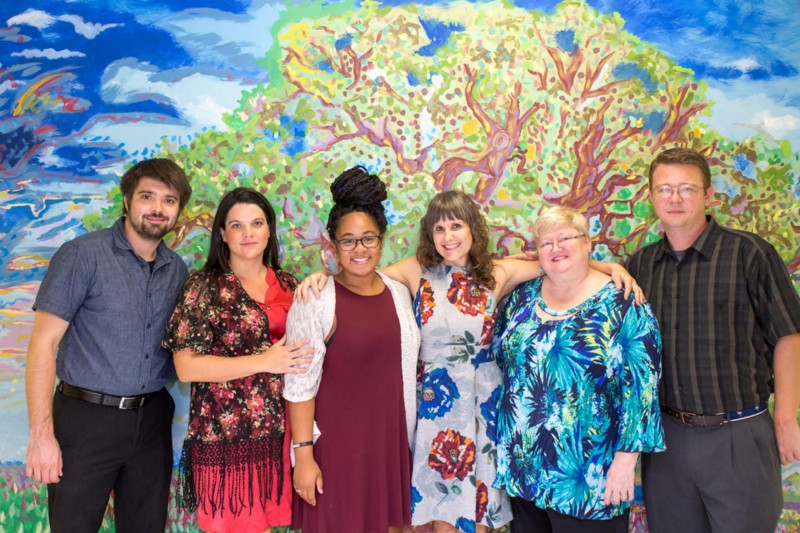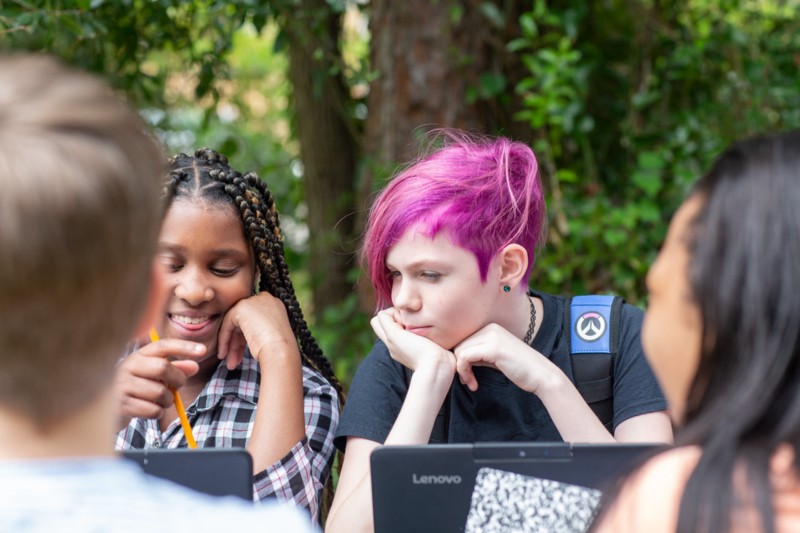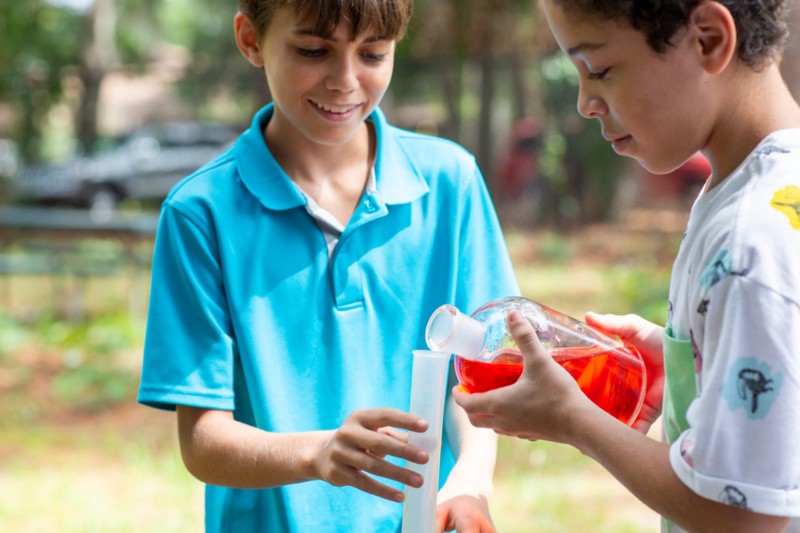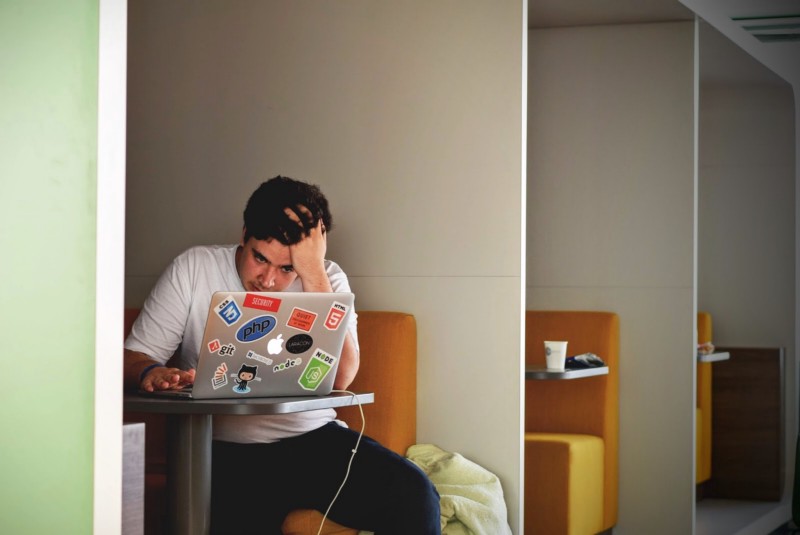Resilience Charter School goes beyond academic learning to help students cultivate the deep resilience needed to solve challenges in life. In speaking with HEADRUSH, Director Jenny Hill says, “We put a lot of hard work into what we do here… but what really shows is the strong community support for our school to have a different approach.”
Tired of seeing students bored and underchallenged with conventional schooling, Jenny felt compelled to work with Resilience to develop a dynamic learning community based on innovation, social justice and relationship building. “Most schools are filled with workbooks and textbooks, where students just sit in chairs all day,” says Jenny. This is clearly not the case for students at Resilience.
Through project-based and social-emotional initiatives, students are encouraged to “think critically, persevere with grit, design creative solutions, and act with mindfulness and compassion.” Building resilience within lies at the core of the school’s mission, empowering students to overcome challenges, gain new insights and build skills.
Here Jenny tells us how the Resilience team guides students to be the best version of themselves for the real world.

Thanks so much for taking the time to talk about Resilience today! So the first thing I noticed from your school’s website are the amazing parent and community testimonials you have…
Yes, we do. In the past three years, we’ve seen a lot of social-emotional growth and it shows. With our method there is a huge trajectory of academic growth across the board, where students are becoming more self aware as learners and are more accountable with their academics and projects. We are still improving and we’ll keep improving going forward…
Do your students typically come from the traditional school system?
Yes, the kids come mostly from a traditional environment and they are most likely to go back to a traditional environment for high school. Students at Resilience are first “unlearning” a certain type of schooling they have been taught… The “I have the information, I give it to you, you repeat it back to me… we move on” system. We do hope that eventually we will offer a high school experience at Resilience. After visiting schools such as Avalon, it is inspiring to see a 7–12 grade model and how they could really build on what they were learning at the time.
The Social-Emotional Learning (SEL) promoted at Resilience seems very special. Tell me more about how you incorporate SEL in the classroom.
We are not using a packaged curriculum like they have out there, despite the rising popularity. Instead, our content is based on a felt need. During each faculty meeting we discuss what is going on right now that we think would be beneficial to our kids to get a little extra exposure to. For example, we may talk about compassion in advisory because we’ve seen some mean behavior happening or lack of compassion… Our mission includes social justice and so we include discussions around awareness of positive body image, LGBTQ rights, how to communicate effectively or conflict resolution. Putting it together organically takes a lot of work but it does seem to be more relevant if it’s current and personal for the students. We use restorative justice as our main fundamental approach to discipline. Do you know much about restorative justice?
I imagine it is more preventative rather than disciplinary… Tell me about how you implement restorative justice at Resilience.
There is an organization we work with called the River Phoenix Center for Peacebuilding. They build initiative in the community to try and incorporate more team building work between the police and youth in the community. These dialogues bring together kids that were in the juvenile justice systems and police officers in order to better understand each other where they train in restorative justice as opposed to punitive corrective behavior. A punitive response is when students mess up and get suspended, then come back a few days later and just go about their business. But the research shows that a punitive system doesn’t make a big impact in terms of adjusting student behavior as there is no active learning in that approach. In the restorative circle, we will not send the child through a standard consequence in the justice system, but agreements will be made to try to repair the harm, and maybe they’ll learn something from the process to keep them from making the same mistake.
So how does it work with students running the restorative dialogue?
We sit down with the students involved, a family member for each of them, and one or more staff members, and we use the same structure where as a group we discuss the situation and decide on how to restore trust in the community. We then make an agreement around what behaviors have to change, and whether students or teachers can step in and help. For some kids this has made a huge difference, especially when they don’t want to leave the school and do what they need to do to change their behavior. It builds empathy as the team sees a little kid, not a big villain, and even parents end up learning lessons and connecting and coaching one another. Everybody just feels the impact of the dialogue and the parents really get to see the kids are genuinely sorry when they mess up and genuinely want to do better.

That must make a big difference in the trust you build with students…
It does. There are also some pretty awful statistics that show the racial disparity that is taking place within school discipline. For example, the rate of black students who are getting school suspensions is dramatically higher than white students, and there is other implicit bias that is happening in schools. It’s easy for a victim to create an image of the criminal as a heartless, cruel person who wants nothing but to hurt somebody, but when they sit down face to face they see this kid who messed up and who sometimes has a trauma in their life, and so they develop a different appreciation for what that kid’s going though. It impacts people and does make a difference.
What a great lesson. It seems as if promoting diversity is important at Resilience.
We have a challenge in that we have a really diverse student body. But I grew up in the school system here and I was in the high achieving and the gifted classes, and I recognized even as a student that it was totally segregated. It was primarily the white kids who had the resources and the black kids who were getting shuffled into the low level classes or the behavior issue classes. Again, there is recent data that shows graduation rates and test scores for minority students in Florida with significant disparity. We have work to do to try to get to the bottom of that and fix it. We made sure our school was located in the north east location where we knew it would more accessible to a lot of minority students because we wanted a diverse student body. We have about 40% minority students with a pretty diverse group… It’s hard when there are so many different needs, but to accommodate every kid that goes here, it’s gonna take a little time.
What has been your biggest learning experience as Director of such a unique, forward-thinking school?
The biggest learning experience for me was the overwhelming nature of opening and trying to run a school with such a diverse student body. As an alternative option, we didn’t know we were going to get applications from students with such unique backgrounds and learning needs. Students with non-traditional needs are most desperate for something different, and we realized we needed to develop a plan to provide such individualized teaching. We pushed through, and are proud of how much we’ve accomplished and feel comfortable telling parents, “There are 10 things we wish were different now and this is where we are at.” We are really proud of our long-term plans and hope to incorporate more and more new initiatives each year, but we all have to be patient because it takes time.

What has helped your personalized learning initiatives?
I love the size that we are right now, with a little over 80 students. Everybody knows everybody, every teacher teaches every student and it works well for the physical space we have. The bigger we grow, the more we have to work to keep the the personalized learning that we are trying to do. HEADRUSH was huge. HEADRUSH really changed everything for us this year, because we knew we needed a PBL learning management system. We tried a different one the first couple of years and every year we went through all these trainings and setup meetings but didn’t feel it was ready to work for us. So when we heard about HEADRUSH from Edvisions, it was such a blessing. It was the perfect timing and it’s nice to have something customizable where we can contribute to the development of the product. Once the students get the hang of it, a teacher can just have the kids log into HEADRUSH and they’ll know what to do. Students get their laptops and get to their own projects and look at the next task they need to work on. Even from home, I’ll get emails that show student activity at 8:00 pm or 6:00 am showing a task completed on HEADRUSH. So if students can’t complete something in class, we just ask they do it from home and they do — all in one system. It’s working really well.
It is great to hear that Resilience is confident and happy using HEADRUSH… Do you have any advice to other schools who are thinking of transitioning to a PBL or SEL landscape?
Definitely. Go visit a school that has already implemented PBL. That was huge for us and we didn’t do it until a year and a half into the school opening, but it changed everything. We kept asking the question, “What does this look like, what is the ideal schedule and where are the kids learning and how…” We couldn’t get these answers until we went and saw it in person and sat down and talked to the staff. Also I think what we are seeing here is that having a small community is what is making the biggest difference. Many students felt lost in a bigger school and they really felt unseen and unheard. Because of the small environment where we can all make observations about the same kids and then make interventions as team decisions, that’s what seems to be making a big difference. If the kids don’t feel safe and supported and don’t feel like they belong when they walk out of the door, the rest of the academic growth can’t happen. We make that our priority, the safety and the emotional well-being of each kid, before we even try to teach them how to read.

